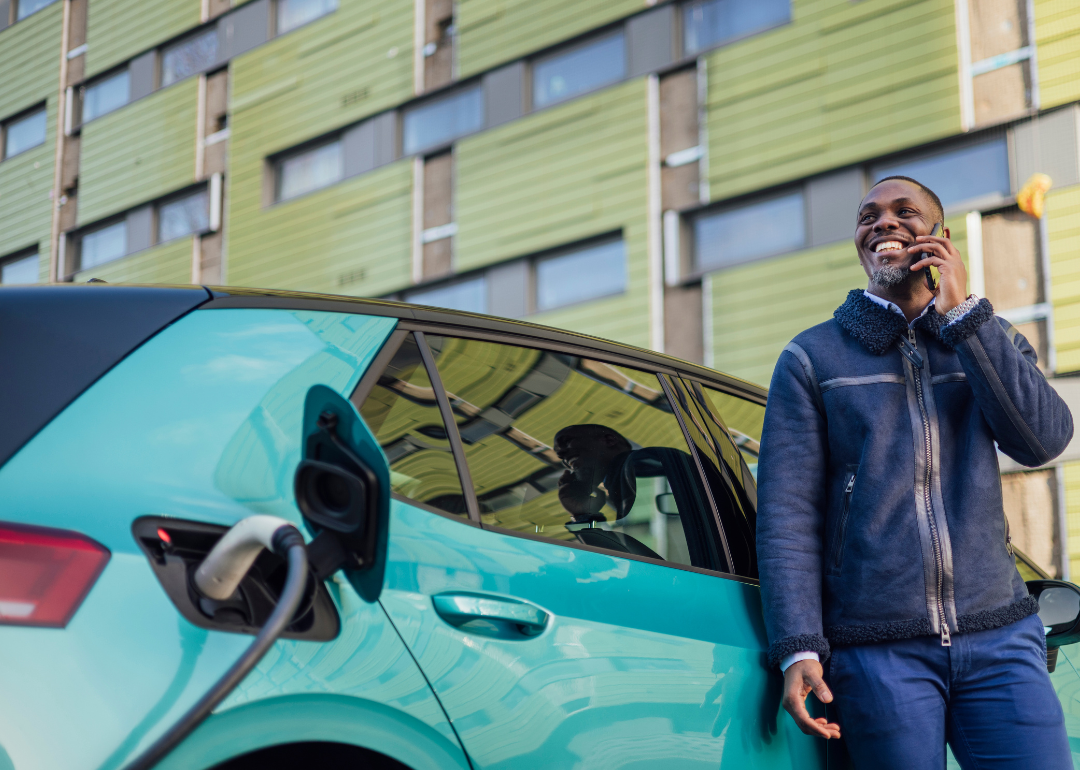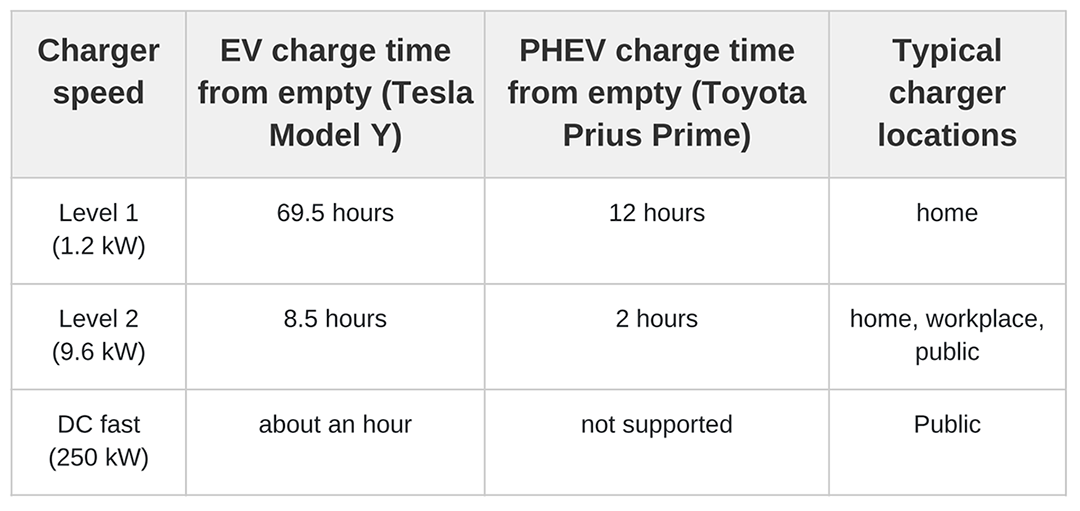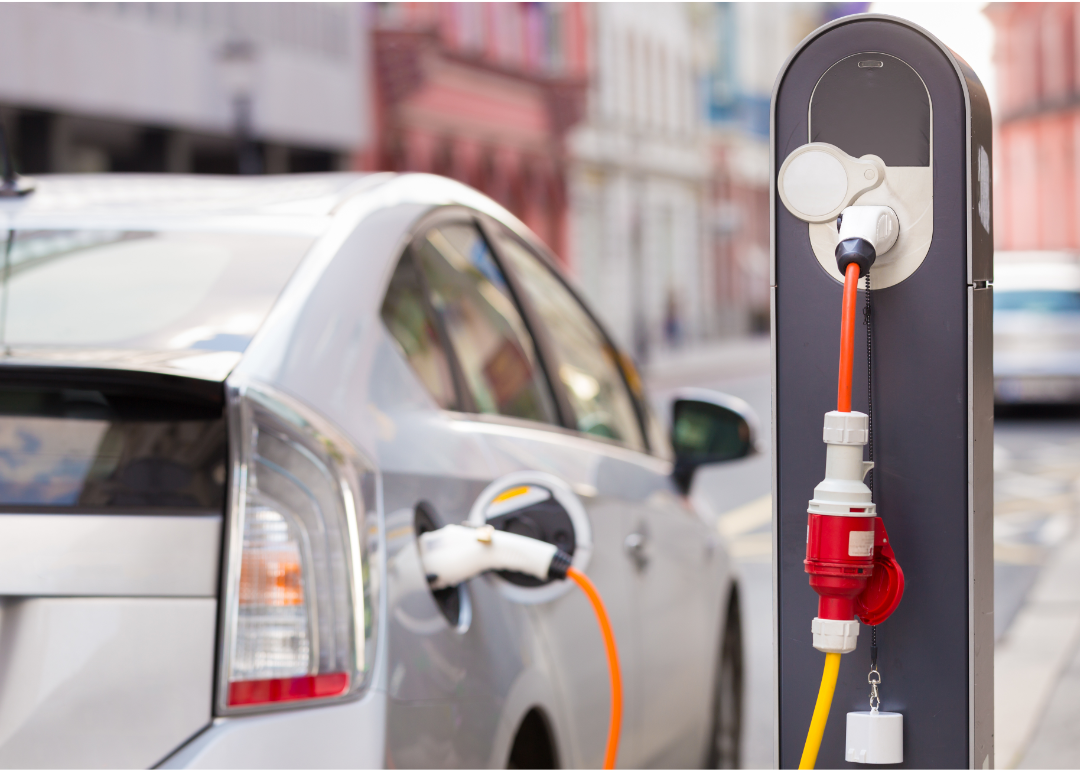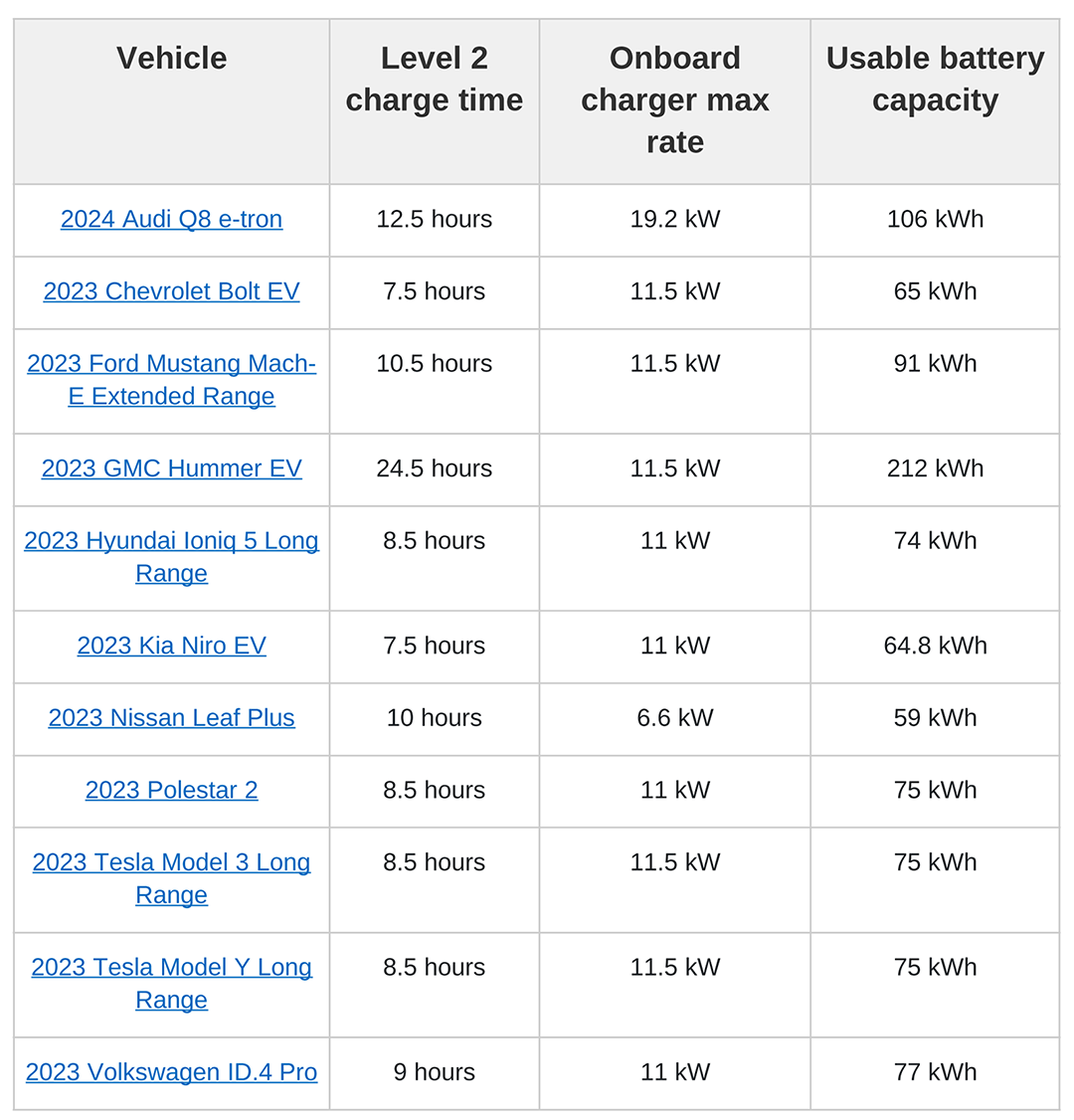
Written by Ronald Montoya
It will take 8 hours to charge a typical electric vehicle from empty to full using a Level 2 home charger, assuming a usable battery capacity of 70 kWh and a charge rate of 9.6 kW. But if you use Level 1 charging — as in a regular household outlet — you’ll need 65 hours to charge the same EV, while a DC fast charger could theoretically do the job in about an hour. To calculate how long it typically takes to reach full capacity for different charge rates, Edmunds takes a closer look at variables that determine how long an electric car will take to charge.
What are the factors that affect electric car charge times?
Here are five key factors that determine the charging time of an electric car:
- Car battery size
- Charging station speed
- The car’s internal charge-rate limits
- Temperature and weather conditions
- Battery charge percentage
How does battery size affect charging?
A larger battery will take longer to charge than a smaller battery, all else being equal. EV battery sizes today range from around 30 kWh to more than 200 kWh. To illustrate the impact of battery size on charging time, consider two EVs, both using Level 2 charging (more on that in the next section) at a rate of 9.6 kW, which is the best-case scenario for home chargers utilizing the common NEMA 14-50 wall outlet. One of our EVs has a usable battery capacity of 40 kWh, the other 80 kWh. Not surprisingly, double the battery size means double the charging time:
Usable battery capacity: 40 kWh
Level 2 charging time (9.6 kW): 4.5 hours from empty to full
Usable battery capacity: 80 kWh
Level 2 charging time (9.6 kW): 9 hours from empty to full
What are the different charging station speeds?
This is the EV equivalent of gas-pump speed, and there are effectively three speeds to be aware of, in order from slow to fast: Level 1, Level 2, and DC fast charging or Level 3.
Level 1 charging
Level 1 charging means using a standard outlet in your home. Level 1 is the most convenient method but also the slowest, charging at roughly 1.2 kW. For example, a 2023 Chevrolet Bolt EV using a standard 120-volt outlet will take approximately 60 hours to get to a full charge from empty. On the extreme end, a 2023 GMC Hummer EV, which has a huge battery, could take 200 hours — eight days! — to charge fully using the same outlet.
Level 1 charging is best for plug-in hybrids such as the Toyota Prius Prime, which has a modest 13.3-kWh battery that would be fully charged in about 12 hours.
Level 2 charging
Level 2 charging uses a 240-volt outlet and represents the fastest way to charge at home, as anything greater can only be found in industrial or commercial settings. Level 2 chargers can be found at your workplace, out in public and at home. You’ll likely need an electrician to install a 240-volt outlet or verify if you have the proper outlet and if your home can accommodate the extra draw in power.
The same Chevy Bolt we referenced earlier would take 7.5 hours to charge from empty to full on a Level 2 charger, assuming a charge rate of 9.6 kW per the NEMA 14-50 setup’s maximum output. The Prius Prime would charge up in about two hours, limited by its 6.6-kW onboard charger. The Hummer EV, though, would need a whopping 24.5 hours to go from zero to a full charge.
Vehicle: 2023 Chevy Bolt EV
Level 1 charging time (1.2 kW): 60 hours
Level 2 charging time (9.6 kW): 7.5 hours
Vehicle: 2023 GMC Hummer EV
Level 1 charging time (1.2 kW): 196 hours
Level 2 charging time (9.6 kW): 24.5 hours
Level 3 (DC fast charging)
DC fast chargers can add range at a rate of 180 to 240 miles per hour, according to a rough estimate by the U.S. Department of Transportation. DC fast chargers are usually found in office parks, shopping centers or dedicated charging stations. It’s called DC (“direct current”) because in this method of charging, the power goes directly to the battery rather than flowing through the vehicle’s onboard charger (more on that below). DC fast stations generally range from 25 kW on the low end to 350 kW on the high end, but don’t expect to get the maximum speed for the entire time. Your car will slow the rate down as it gets closer to a full charge, while the output of the DC fast charger itself can also fluctuate based on multiple factors.
DC fast-charging stations are the most expensive way to charge up your EV, and a full charge sometimes approaches the price of a tank of gas. This is due in significant part to their high installation and maintenance costs. We also should note that extended use of DC fast chargers is hard on the battery due to the higher temperatures generated, which can shorten its lifespan. DC fast-charging stations are best used for road trips or when you need to top off for a long day of driving.

Edmunds
Comparing Tesla Model Y and Toyota Prius Prime charging
We use the Tesla Model Y rather than the Chevy Bolt as our EV example because the Bolt EV struggles at DC fast chargers. Specifically, the Bolt EV’s battery management system limits its DC fast-charging rate to just 55 kW, which puts it at the back of today’s EV pack. The Model Y can charge at up to 250 kW, which is the maximum charge rate at Tesla Supercharger stations. As for the Prius Prime, its lack of support for DC fast charging is typical of plug-in hybrids.
Can the car itself limit the maximum charging speed?
Yes, there are two ways in which the electric car itself sets limits on how quickly you can charge. The onboard charger limits the rate for Level 1 and Level 2 charging, while the battery management system limits the rate for DC fast charging, which bypasses the onboard charger.
How does the onboard charger limit max charging speed?
The onboard charger, which is actually inside the vehicle, determines the charging speed with Level 1 and Level 2 chargers. An electric car’s onboard charger receives AC power through the charge port and converts it into DC power that the EV battery can use and store. The onboard charger is rated in kilowatts — a bigger number offers a faster charge. The current Chevy Bolt, for example, uses an 11.5-kW onboard charger. Compare that to the slower 6.6-kW charger on the rival Nissan Leaf and you get a sense of how much of a difference this can make in EV charging time. The Porsche Taycan, one of the fastest-charging EVs, can be ordered with a 19.2-kW onboard charger.

Canva
What determines a car’s max charging speed at a DC fast charger?
As noted, DC fast charging bypasses the onboard charger and delivers electricity straight to the battery. It allows an electric car to receive more electrical current and charge at a faster speed. In the DC fast (Level 3) scenario, the charge speed is governed by the vehicle’s battery management system. This system is designed to let the battery charge as quickly as possible without overheating it or otherwise taxing its components.
Each battery management system has its own maximum charging speed, which is important to know when selecting a charging station. As mentioned above, the 2023 Chevrolet Bolt EV has a maximum charge rate of only 55 kW, while the 2023 Mustang Mach-E has a maximum charge rate of 150 kW and most Teslas can achieve a maximum rate of 250 kW. So if you owned a Bolt EV and parked at a 150-kW charging station, the higher speed of that station would do you no good because your car is limited to 55 kW. As a courtesy, it’s good to know these speeds so that other cars that need that extra speed can use it, although if you’re running low on juice and need to recharge, there may be no alternative.
Temperature and weather conditions
Batteries like to be in the Goldilocks zone, not too hot and not too cold. This maxim applies both when charging and when driving in extreme temperatures. Colder temperatures will not only lead to longer charging times, they’ll also cut down on your range. Hot temperatures, meanwhile, can lead to greater wear on the battery since the chemical reactions are happening at higher temperatures than normal. This can potentially shorten the battery’s lifespan. The higher the temperature, the more stress it places on the battery and the way its energy flows.
Using the climate control system also tends to reduce range. Using the heater has the greatest effect on range since an electric car doesn’t have an engine to generate heat like a gas car. A study by AAA concluded that on a 20-degree Farenheit day with the heater on, the driving range decreases by 41%. On a 95-degree day with the air conditioner on, AAA found that the range decreases by about 17%.
Battery charge percentage when charging starts
Think of charging an electric car as trying to fill a glass with water from a pitcher. You’ll start out fast at first, but as the glass starts to get full, you need to slow down the stream to avoid overflowing and spilling the water. The same logic applies to charging an electric car. This means that if you arrive at a charge station with a nearly depleted battery, it will charge at a faster rate than if you showed up with the battery three-quarters full. The sweet spot for most batteries, whether in cars or smartphones, is from 20% to 80%. If you keep your electric car between those ranges, the battery will have a greater lifespan.
Since the charge needs to slow down as the battery is nearly full, going from 80% to 100% will take significantly longer. Most manufacturers recommend charging to 80% capacity for daily driving and only going to 100% when you need to take a longer road trip. This approach will not only take care of the battery but also reduce the time spent charging.
How long does it take to charge a Tesla?
Tesla’s proprietary Supercharger network merits a separate entry. Superchargers are classified as DC fast chargers, supporting a peak charge rate of up to 250 kW per vehicle. According to Tesla’s site, which assumes that the vehicles are operating at peak efficiency and the max charge rate, the Tesla Model Y can recover up to 162 miles in 15 minutes, the Tesla Model 3 and the Tesla Model X can charge up to 175 miles in 15 minutes, and the Tesla Model S is the leader with a rate of up to 200 miles in 15 minutes. If you want to charge from zero to 100%, though, you’ll probably need at least an hour due to the dramatically slower charge rate as the battery approaches a full charge. In light of the White House’s announcement that the Supercharger network will be opening up to other brands, it will be interesting to see what kind of charging performance non-Tesla models can achieve at Supercharger stations.

Edmunds
What are the charging times of popular electric vehicles?
Level 2 charging times vary among some popular EVs, assuming a charge rate of 9.6 kW and that you’re charging from zero to 100%. In the case of one vehicle — the Nissan Leaf Plus — the onboard charger’s maximum charge rate is less than 9.6 kW, which means the lower number is the effective charge rate.
All the factors that influence electric car charge speeds might seem overwhelming, but think of it this way: Many of these factors, including the weather, how full the tank is, and what pump you’re using, also affect gas-powered cars. Understanding how long it takes to charge an electric car is just a matter of reframing and learning a few more concepts.
This story was produced by Edmunds and reviewed and distributed by Stacker Media.















